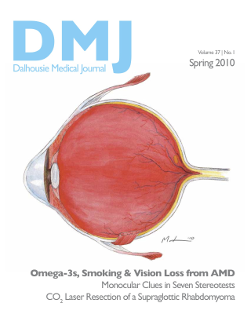CO2 Laser Resection of a Supraglottic Rhabdomyoma: Case Report and Review
DOI:
https://doi.org/10.15273/dmj.Vol37No1.3865Abstract
Rhabdomyomas are rare benign tumours of striated muscle tissue that can be divided into cardiac and extracardiactypes. Cardiac rhabdomyomas are associated with tuberous sclerosis, whereas extracardiac varieties are notassociated with any particular syndrome. Approximately 70% of rhabdomyomas found outside the heart occur inthe head and neck. Rhabdomyomas are typically solitary lesions, although multifocal lesions have been described;however, there have been no reports of malignant transformation to rhabdomyosarcomas. There have been 32 casesof laryngeal rhabdomyoma reported. Of these, 10 cases were reported in the supraglottic space. We present the 11threported case of a supraglottic rhabdomyoma, and the first to be managed with laser resection without recurrenceof the tumour.Downloads
Published
2010-04-12
How to Cite
O'Brien, J. D., Belyea, J., Hart, R., Trites, J., & Taylor, S. M. (2010). CO2 Laser Resection of a Supraglottic Rhabdomyoma: Case Report and Review. DALHOUSIE MEDICAL JOURNAL, 37(1). https://doi.org/10.15273/dmj.Vol37No1.3865
Issue
Section
Case Report
License
Authors who publish with this journal agree to the following terms:
- Authors retain copyright and grant the journal right of first publication with the work simultaneously licensed under a Creative Commons Attribution License that allows others to share the work with an acknowledgement of the work's authorship and initial publication in this journal.
- Authors are able to enter into separate, additional contractual arrangements for the non-exclusive distribution of the journal's published version of the work (e.g., post it to an institutional repository or publish it in a book), with an acknowledgement of its initial publication in this journal.
- Authors are permitted and encouraged to post their work online (e.g., in institutional repositories or on their website) prior to and during the submission process, as it can lead to productive exchanges, as well as earlier and greater citation of published work (See The Effect of Open Access).


